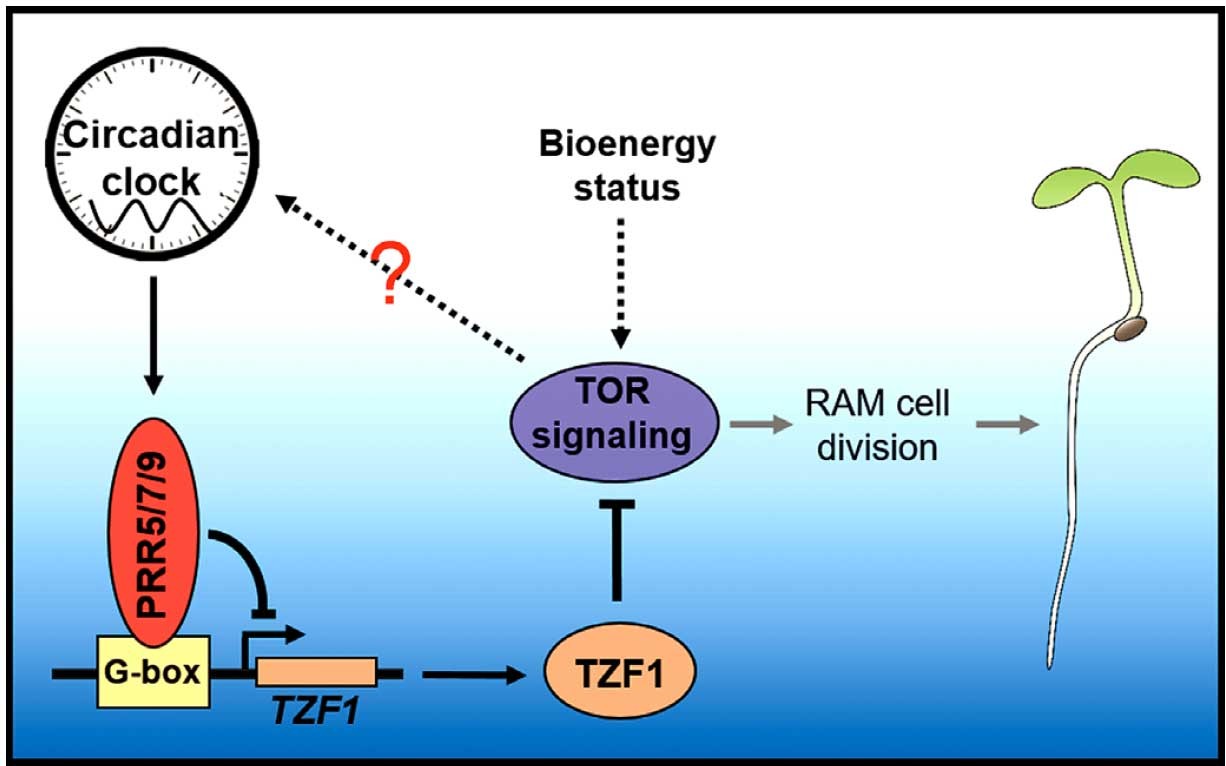博文
Nucleic Acids Research:植物生物钟控制细胞增殖的分子机制
||
PRR5, 7 and 9 positively modulate TOR signaling-mediated root cell proliferation by repressing TANDEM ZINC FINGER 1 in Arabidopsis
First author: Bin Li; Affiliations: Institute of Botany, Chinese Academy of Sciences (中科院植物所): Beijing, China
Corresponding author: Lei Wang
Circadian clock coordinates numerous plant growth and developmental processes including cell elongation in the hypocotyl, whether or not it modulates cell proliferation is largely unknown. Here we have found that Pseudo Response Regulators (PRRs), essential components of circadian core oscillators, affect root meristem cell proliferation mediated by Target Of Rapamycin (TOR) signaling. The null mutants of PRRs display much reduced sensitivities to sugar-activated TOR signaling. We have subsequently identified Tandem Zinc Finger 1, encoding a processing body localized RNA-binding protein, as a direct target repressed by PRRs in mediating TOR signaling. Multiple lines of biochemical and genetic evidence have demonstrated that TZF1 acts downstream of PRRs to attenuate TOR signaling. Furthermore, TZF1 could directly bind TOR mRNA via its tandem zinc finger motif to affect TOR mRNA stability. Our findings support a notion that PRR-TZF1-TOR molecular axis modulates root meristem cell proliferation by integrating both transcriptional and post-transcriptional regulatory mechanisms.
生物钟协调多方面的植物生长和发育进程,包括下胚轴的细胞伸长,然而其是否调控细胞增殖还不清楚。本文的研究显示植物生物钟核心振荡器的组份PRR会通过TOR信号途径影响根分生组织细胞的增殖。PRR突变体对于受蔗糖激活的TOR信号转导的敏感度显著降低。随后,作者鉴定了一个编码加工体局部RNA结合蛋白的Tandem Zinc Finger 1基因,在PRR介导TOR信号转导过程该基因能够被PRR直接靶向抑制。生化试验和遗传学证据显示TZF1在PRRs的下游发挥作用,减弱TOR的信号转导。此外,TZF1能够通过其本身串联的锌指基序直接结合到TOR的mRNA上,影响TOR mRNA的稳定性。本文的研究揭示了PRR-TZF1-TOR分子模块通过转录前和转录后两种调控方式控制植物根分生组织细胞的增殖。
通讯:王雷 (http://sourcedb.ib.cas.cn/cn/expert/201402/t20140217_4033081.html)
个人简介:1999年,东北师范大学,学士; 2002年,吉林农业大学,硕士; 2006年,中国科学院植物研究所,博士; 2006-2013年,美国俄亥俄州立大学,博士后; 2010-2010年,韩国浦项科技大学,访问学者。
研究方向:植物生物钟分子系统的组成解析及关键因子的转录后水平调控;水稻生物钟分子系统的表观遗传控制分子机制;生物钟分子系统对植物发育的调控及相关分子机理。
doi: https://doi.org/10.1093/nar/gkz191
Journal: Nucleic Acids Research
Published date: March 20, 2019
https://blog.sciencenet.cn/blog-3158122-1169354.html
上一篇:Nature Genetics:陆地棉和海岛棉基因组
下一篇:the plant journal:拟南芥胚胎的成熟并不依赖于胚乳细胞化
全部作者的其他最新博文
- • Plant Physiology:CsMADS3促进柑果中的叶绿素降解和类胡萝卜素合成(华中农业大学)
- • Molecular Plant:LBD11-ROS反馈调节作用于拟南芥的维管形成层增殖和次生生长(浦项科技大学)
- • Science Advances:根结线虫通过调控植物的CLE3-CLV1模块,促进侵染进程(日本熊本大学)
- • Nature Communications:油菜素内酯参与植物营养生长期转变的分子机制解析(浙江农林大学)
- • Current Biology:光合作用产生的蔗糖驱动侧根“生物钟”(德国弗莱堡大学)
- • PNAS:花同源异型基因在叶中被抑制、花中被激活的分子机制(南卡罗来纳大学)

